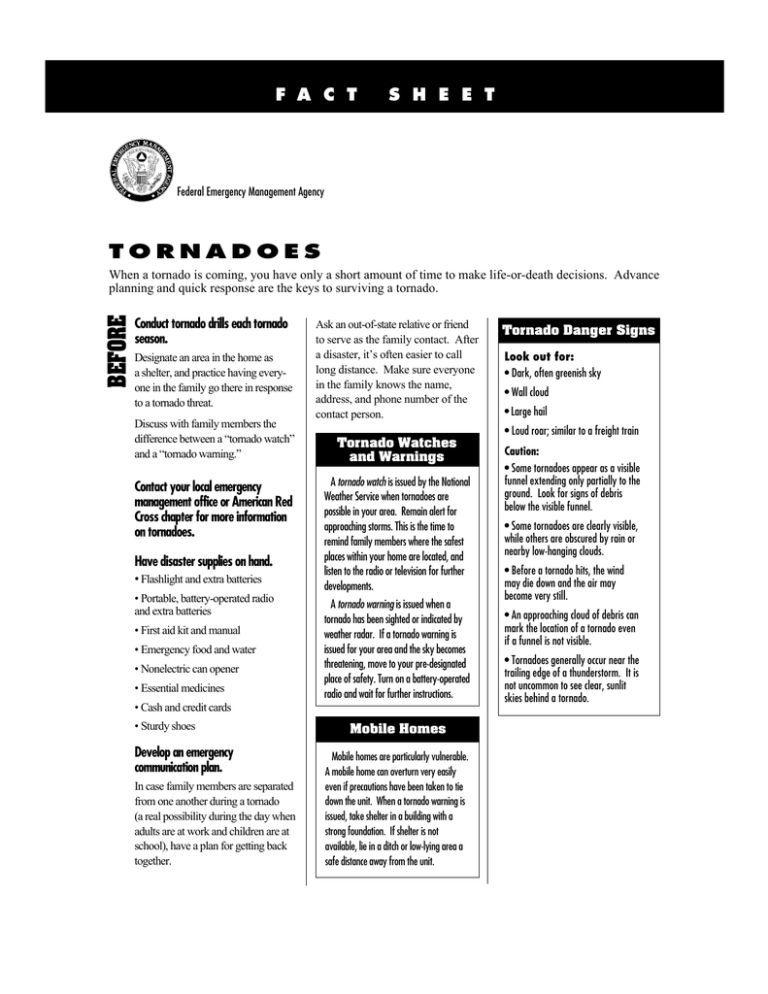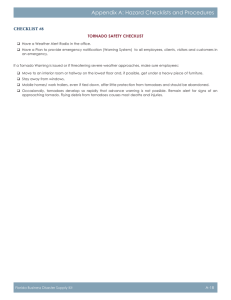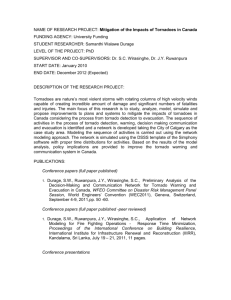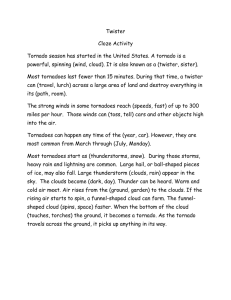Welcome to the New Site! – OK Dept. of Libraries
advertisement

F A C T S H E E T Federal Emergency Management Agency TORNADOES BEFORE When a tornado is coming, you have only a short amount of time to make life-or-death decisions. Advance planning and quick response are the keys to surviving a tornado. Conduct tornado drills each tornado season. Designate an area in the home as a shelter, and practice having everyone in the family go there in response to a tornado threat. Discuss with family members the difference between a “tornado watch” and a “tornado warning.” Contact your local emergency management office or American Red Cross chapter for more information on tornadoes. Have disaster supplies on hand. • Flashlight and extra batteries • Portable, battery-operated radio and extra batteries • First aid kit and manual • Emergency food and water • Nonelectric can opener • Essential medicines Ask an out-of-state relative or friend to serve as the family contact. After a disaster, it’s often easier to call long distance. Make sure everyone in the family knows the name, address, and phone number of the contact person. Tornado Watches and Warnings A tornado watch is issued by the National Weather Service when tornadoes are possible in your area. Remain alert for approaching storms. This is the time to remind family members where the safest places within your home are located, and listen to the radio or television for further developments. A tornado warning is issued when a tornado has been sighted or indicated by weather radar. If a tornado warning is issued for your area and the sky becomes threatening, move to your pre-designated place of safety. Turn on a battery-operated radio and wait for further instructions. • Cash and credit cards • Sturdy shoes Develop an emergency communication plan. In case family members are separated from one another during a tornado (a real possibility during the day when adults are at work and children are at school), have a plan for getting back together. Mobile Homes Mobile homes are particularly vulnerable. A mobile home can overturn very easily even if precautions have been taken to tie down the unit. When a tornado warning is issued, take shelter in a building with a strong foundation. If shelter is not available, lie in a ditch or low-lying area a safe distance away from the unit. Tornado Danger Signs Look out for: • Dark, often greenish sky • Wall cloud • Large hail • Loud roar; similar to a freight train Caution: • Some tornadoes appear as a visible funnel extending only partially to the ground. Look for signs of debris below the visible funnel. • Some tornadoes are clearly visible, while others are obscured by rain or nearby low-hanging clouds. • Before a tornado hits, the wind may die down and the air may become very still. • An approaching cloud of debris can mark the location of a tornado even if a funnel is not visible. • Tornadoes generally occur near the trailing edge of a thunderstorm. It is not uncommon to see clear, sunlit skies behind a tornado. If in a car: ■ Go at once to the basement, storm ■ Never try to outdrive a tornado in a cellar, or the lowest level of the building. car or truck. Tornadoes can change direction quickly and can lift up a car or truck and toss it through the air. ■ If there is no basement, go to an inner hallway or a small inner room without windows, such as a bathroom or closet. ■ Get out of the car immediately and take shelter in a nearby building. ■ If there is no time to get indoors, get out of the car and lie in a ditch or low-lying area away from the vehicle. Be aware of the potential for flooding. ■ Get away from windows. ■ Go to the center of the room. Stay away from corners because they tend to attract debris. ■ Get under a piece of sturdy furniture such as a workbench or heavy table and hold on to it. ■ Use arms to protect head and neck. ■ If in a mobile home, get out and find shelter elsewhere. Help injured or trapped persons. AFTER DURING If at home: Give first aid when appropriate. Don’t try to move the seriously injured unless they are in immediate danger of further injury. Call for help. ■ Turn on radio or television to get If at work or school: the latest emergency information. ■ Go to the basement or to an inside ■ Stay out of damaged buildings. hallway at the lowest level. Return home only when authorities say it is safe. ■ Avoid places with wide-span roofs such as auditoriums, cafeterias, large hallways, or shopping malls. ■ Get under a piece of sturdy furniture such as a workbench or heavy table or desk and hold on to it. ■ Use arms to protect head and neck. If outdoors: ■ Use the telephone only for no time to get indoors, lie in a ditch or low-lying area or crouch near a strong building. Be aware of the potential for flooding. Check for gas leaks — If you smell gas or hear a blowing or hissing noise, open a window and quickly leave the building. Turn off the gas at the outside main valve if you can and call the gas company from a neighbor’s home. If you turn off the gas for any reason, it must be turned back on by a professional. Look for electrical system damage — If you see sparks or broken or frayed wires, or if you smell hot insulation, turn off the electricity at the main fuse box or circuit breaker. If you have to step in water to get to the fuse box or circuit breaker, call an electrician first for advice. Check for sewage and water lines damage — If you suspect sewage lines are damaged, avoid using the toilets and call a plumber. If water pipes are damaged, contact the water company and avoid using water from the tap. You can obtain safe water by melting ice cubes. emergency calls. ■ Clean up spilled medicines, bleaches or gasoline or other flammable liquids immediately. Leave the building if you smell gas or chemical fumes. Take pictures of the damage — both to the house and its contents — for insurance purposes. ■ ■ If possible, get inside a building. ■ If shelter is not available or there is Inspecting Utilities in a Damaged Home Remember to help your neighbors who may require special assistance — infants, the elderly, and people with disabilities. Mitigation Mitigation includes any activities that prevent an emergency, reduce the chance of an emergency happening, or lessen the damaging effects of unavoidable emergencies. Investing in preventive mitigation steps now, such as checking local building codes and ordinances about wind-resistant designs and strengthening unreinforced masonry, will help reduce the impact of tornadoes in the future. For more information on mitigation, contact your local emergency management office. ■ Use arms to protect head and neck. EMERGENCY PUBLIC INFORMATION September 1993 B A C K G R O U N D E R T O R N A D O E S EMERGENCY INFORMATION 1. The best protection during a tornado is in an interior room on the lowest level of a building, preferably a basement or storm cellar. 2. Tornadoes strike with incredible velocity. Wind speeds may approach 300 miles per hour. These winds can uproot trees and structures and turn harmless objects into deadly missiles, all in a matter of seconds. Mobile homes are particularly vulnerable to tornadoes. 3. Injuries or deaths related to tornadoes most often occur when buildings collapse, people are hit by flying objects or are caught trying to escape the tornado in a car. 4. Tornadoes are most destructive when they touch ground. Normally a tornado will stay on the ground for no more than 20 minutes; however, one tornado can touch ground several times in different areas. WHAT IS A TORNADO? A tornado is a violent windstorm characterized by a twisting, funnel- shaped cloud. It is spawned by a thunderstorm (or sometimes as a result of a hurricane) and produced when cool air overrides a layer of warm air, forcing the warm air to rise rapidly. The damage from a tornado is a result of the high wind velocity and wind- blown debris. Tornado season is generally March through August, although tornadoes can occur at any time of year. They tend to occur in the afternoons and evenings: over 80 percent of all tornadoes strike between Tornadoes can occur in any state but are more frequent in the Midwest, Southeast, and Southwest. The states of Alabama, Arkansas, Florida, Georgia, Illinois, Indiana, Iowa, Kansas, Louisiana, Mississippi, Missouri, Nebraska, Oklahoma, South Dakota, and Texas are at greatest risk. noon and midnight. HELP YOUR COMMUNITY GET READY The media can raise awareness about tornadoes by providing important information to the community. Here are some suggestions: 1. Publish a special section in your local newspaper with emergency information about tornadoes. Localize the information by printing the phone numbers of local emergency services offices, the American Red Cross, and hospitals. 2. Periodically inform your community of local public warning systems. 3. Sponsor a “Helping Your Neighbors” program at your local schools to encourage children to think of those persons who require special assistance such as elderly people, infants, or people with disabilities. 4. Conduct a series on how to protect yourself during a tornado in case you are at home, in a car, at the office, or outside. 5. Interview local officials about what people living in mobile home parks should do if a tornado warning is issued. D I D Y O U ■ Tornadoes can be nearly invis- ible, marked only by swirling debris at the base of the funnel. Some are composed almost entirely of windblown dust and still others are composed of several mini-funnels. ■ On average, the United States experiences 100,000 thunderstorms each year. Approximately 1,000 tornadoes develop from these storms. ■ Although tornadoes do occur throughout the world, the United States experiences the most intense and devastating tornadoes. K N O W. . . ■ Tornadoes produce the most violent winds on earth. Tornado winds can approach speeds as high as 300 miles per hour, travel distances over 100 miles and reach heights over 60,000 feet above ground. ■ In November 1988, 121 tornadoes struck 15 south central states, resulting in 14 lives lost and damages reaching $108 million. ■ According to the National Weather Service, about 42 people are killed because of tornadoes each year. HOW THE PUBLIC CAN HELP AFTER A DISASTER When disaster strikes, people everywhere want to help those in need. To en- sure that this compassion and generosity are put to good use, the media can highlight these facts: Financial aid is an immediate need of disaster victims. Financial contributions should be made through a recognized voluntary organization to help ensure that contributions are put to their intended use. Before donating food or clothing, wait for instructions from local officials. Immediately after a disaster, relief workers usually don’t have the time or facilities to setup distribution channels, and too often these items go to waste. Volunteers should go through a recognized voluntary agency such as the American Red Cross or Salvation Army. They know what is needed and are prepared to deal with the need. Local emergency services officials also coordinate volunteer efforts for helping in disasters. Organizations and community groups wishing to donate items should first contact local officials, the American Red Cross, or Salvation Army to find out what is needed and where to send it. Be prepared to deliver the items to one place, tell officials when you’ll be there, and provide for transportation, driver, and unloading. EMERGENCY PUBLIC INFORMATION September 1993





